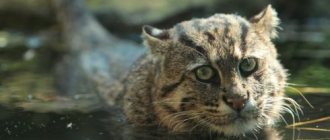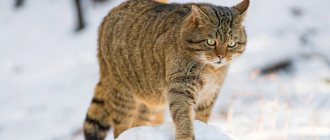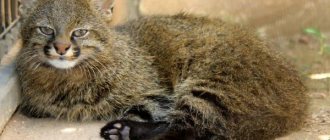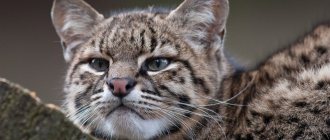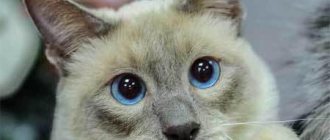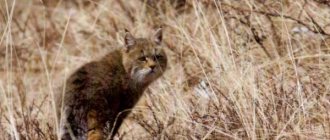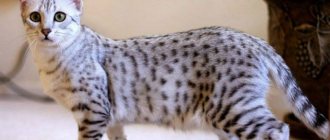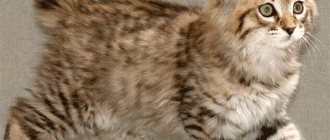The rarest cat breeds in the world are listed in the Red Book. This list includes the little-studied Caucasian forest cat, which lives in the countries of Central Asia, Eastern and Western Europe. She leads a secretive lifestyle and prefers hard-to-reach habitats.
What interesting things have experts learned about this rare breed, and what qualities attract the Caucasian forest cat? Is it possible to keep such a predator at home? You will find answers to these and other questions in our article today!
History of the species
The Caucasian forest cat is a small predator of the cat family, one of those wild animals that have retained their appearance unchanged over millions of years.
In total, there are 23 subspecies of forest cats, and the animal living in the Caucasus Mountains is one of its largest representatives.
The morphology of the animal was formed almost during the Ice Age. Most representatives of the fauna of the Pleistocene period of the Quaternary geological epoch did not survive to this day and became extinct due to global warming. These are, for example, mammoths, woolly rhinoceroses, cave lions.
Caucasian forest cats migrated to the cool zones of foothill forests and managed to retain abundant hair, sharp claws and impressive size for a cat.
Habitats
Wild cats of the Caucasus are also represented by steppe and Central European subspecies. The territories they inhabit stretch from the Black Sea coast to mountainous regions of 2500-3000 m.
The best biotopes for life are virgin broad-leaved forests, but the Caucasian forest cat is also found in the coniferous forests of the Krasnodar Territory and adjacent areas.
Global habitat - the entire Caucasus and Asia Minor. The total area of temporary and permanent places where they can be found is about 1,360 thousand hectares. The nature of these places is diverse: crooked forests, beech groves, fir forests, rocky slopes, sparse trees.
Wild cats of the Krasnodar Territory and the Crimean region make up the largest population of these cats. Particularly high density is observed in the foothills.
Mr. Cat recommends: characteristics, range of the Caucasian forest cat
The Caucasian forest cat is practically no different from its Central European counterpart.
The main characteristics of the animal's appearance are as follows:
- Quite large sizes. The weight of individuals is from 5 to 13 kg, while females are significantly smaller than males.
- Males reach 65-90 cm in length, cats 55-63 cm.
- The body is strong, massive, muscular. Females have a more graceful structure due to their less voluminous neck.
- The head is medium in size, but appears massive and round due to wide cheekbones.
- The eyes are quite large, yellow, green or swamp-golden in color.
- The ears are large, but not too large, set quite high, and have no tufts, only an inner edge.
- The legs are of medium length, but the hind legs are much longer than the front ones.
- The claws are sharp and strong; they are often ground down on rocks.
- The tail is long, matching the length of the body. It is powerfully pubescent, seems very thick, its tip is rounded.
- Medium length coat with voluminous undercoat.
- The cover is much thicker and longer in winter. In summer, the coat appears shorter and lighter.
- The color is in grayish tones with dark stripes and markings on the forehead, sides, and upper paws. There are several dark rings on the tail. Sometimes there are ocher and brownish colors.
- The vibrissae are large, voluminous and long, white.
- Coarse tufts of hair also grow between the toes on the pads of the feet.
Felis silvestris caucasica live mainly in deciduous mixed forests of the foothills of the Caucasus; they are found in Dagestan, Chechnya, Kabardino-Balkaria, North Ossetia, Georgia, Armenia, Azerbaijan, Adygea and Turkey. Their Central European and steppe counterparts often live next to these animals.
In the Krasnodar and Stavropol regions, this animal also inhabits foothill coniferous forests. In total, its habitat area in the Caucasus and Asia Minor is small, up to one and a half thousand hectares.
This is one of the smallest subspecies of the wild forest cat. So, in Dagestan there are only about a hundred individuals.
They are able to live at an altitude of 2-3 thousand meters above sea level.
In treeless areas, they inhabit floodplains - often flooded areas in river floodplains or near lakes, covered with reeds, thistles and shrubs. Although the beast does not like water.
Description of the animal
The weight of the female ranges from 3 to 6 kg, the male can reach 6.8 kg. There were individuals that gained weight of 11 kg. The body reaches a length of 50 cm. The head is round, the eyes are expressive. The eyes have a third membrane that protects the organ of vision from damage.
The voice is hoarse, makes sounds characteristic of cats, but with a much greater emotional coloring. It not only meows, but also growls, hisses, snorts, and howls.
The tracks of a wild animal are the same as those of a domestic animal. The only difference is the larger size. It climbs trees well and has sharp retractable claws on its paws. The hind legs have four toes, the front legs have five.
| Scientific classification | |
| Kingdom | Animals |
| Type | Chordata |
| Class | Mammals |
| Squad | Predatory |
| Family | Felines |
| Genus | Cats |
| View | forest cat |
| Subspecies | Caucasian forest cat |
| Latin name | Felis silvestris caucasica |
In the mouth there are sharp fangs, with the help of which the animal holds and kills prey, and molars, intended for chewing meat. The tongue is hard, allows you to lick meat and care for the coat.
What does it look like
The Caucasian cat looks like an ordinary domestic mongrel cat, except that it is larger in size. The coloring is gray, with a small reddish mark. There is a black stripe along the ridge. There are also short transverse stripes on the sides and on the head to the back of the head.
The belly, throat and groin area are covered with light yellow fur. There are sometimes dark spots on the stomach. The tail is striped, with dark rings on a gray background. There can be from three to eight. In summer the color is brighter than in winter. During the cold season, the coat becomes thicker.
This coloring allows the animal to camouflage well while hunting. The cat goes hunting at night, and often sits in ambush.
Character and lifestyle
Settles in hollows, crevices, heron nests, abandoned burrows of badgers or foxes. May live in abandoned houses or near housing. It can also live in thickets of bushes or reeds. Prefers to lead a solitary lifestyle. Each individual has its own controlled territory. Usually it does not exceed three kilometers.
The peculiarity of the animal is that to mark the territory, the cat not only sprays urine, but also uses the secretion of special glands that are located around the mouth, on the forehead and near the base of the tail. The cat rubs against different surfaces and leaves an individual smell.
This is a solitary animal, but in places with high numbers, a certain hierarchy is formed between individuals that are often in contact. To protect its own territory, it can be belligerent.
The animal prefers to sit in ambush for a long time and wait for the right moment to attack. A sharp jump from an ambush can reach three meters. Sometimes it catches up with prey, but such cases are very rare.
A wild forest cat can swim, but will not get into the water without a special reason.
What does it eat?
The basis of the diet is small rodents, lizards and birds. It can also hunt pheasants or small-sized artiodactyls (young individuals). Very rarely catches fish or crayfish. Can also eat roots or some herbs.
During periods of food shortage, it can hunt hares or domestic animals. It can also destroy nests for eggs or chicks. Sometimes it feeds on young cereals, fresh carrion or fruits.
The wild cat is a highly successful hunter and poses a danger to river rats, waterfowl, squirrels, stoats, young large animals, as well as injured goats and other herbivores. Often attacks domestic animals and gets into fights with dogs.
When hunting large prey, it tries to gnaw through the carotid artery. In hunted large animals, the liver, heart, and lungs are primarily eaten.
Where does it live?
The animal is found in the forests of Central Asia, Western and Eastern Europe. Prefers deciduous and fir forests. The Caucasian forest cat on the territory of the Russian Federation is found only in the Krasnodar Territory. The number of this species is so small that records are kept of each individual.
This species is considered the largest among forest cats. In the Red Book, this species is number three, as one of the rarest species that are on the verge of extinction. Found in the lower reaches of the Kuban and Terek.
Reproduction
The mating season lasts from February to March. The female secretes special substances that attract males. A cat bears kittens for approximately 70 days.
There are three to five babies in the litter, which feed on mother's milk for four months. Only the female is responsible for raising the cubs, although cases have been recorded when the male brought prey to the den of the female with the cubs.
If the first litter of the season dies, the female is able to become pregnant again. Sexual maturity occurs at 9-10 months (females) or three years (males). Life expectancy in the zoo is 30 years, in the wild - 15.
Natural enemies
Lynxes, jackals, jungle cats, martens and foxes can pose a danger to the animal. In case of a threat to life, the animal develops high speed or climbs to the tops of trees.
Wintering
During snowy and cold winters, annual seasonal migrations occur to places more suitable for habitation. Deep snow prevents rapid movement, which is why the wild cat is forced to change its place of residence. If conditions are favorable, the animal spends the winter where it lives.
Features of behavior
In forest foothills, the Caucasian forest cat usually makes a den in a tree in a hollow; it can also take a liking to the abandoned nest of a heron, an eagle or a stork.
In rocky areas, shelters become crevices in rocks, holes left by badgers, foxes, and sometimes even wolves.
In the floodplains, it can choose an entire island as its zone, arranging a den and a playground for the young in its center. The toilet area is usually located near the water itself.
Caucasian forest cats are very cautious animals that lead a rather secretive lifestyle, preferring a solitary existence.
One adult male usually chooses “his” territory of two to three square meters. km. Its boundaries are carefully marked with urine, and characteristic scratches are left on tree trunks.
They move to new lands extremely rarely and reluctantly, only due to human intervention or when the food supply is scarce.
It goes hunting in the twilight hours, before sunset or dawn. Never pursues prey, always uses wait-and-see tactics. It kills the victim in a swift jump, biting the back of the head or neck.
All forest predators that are comparable to or larger than the Caucasian cat are his enemies - bears, lynxes, wolves, foxes, martens, weasels, jackals. It is not easy to catch up with the animal; it immediately hides in a tree or in emergency shelters on “its” territory.
Diet
The Caucasian forest cat is a medium-sized predator that is excellent at climbing trees and rocks. To hunt, the animal prefers to go down to the ground.
Most of its diet consists of rodents - mice, voles, dormice. I am ready to fight with such brave enemies as weasel, ermine, raccoon, rat, muskrat, nutria. Capable of catching a hare, snake, baby roe deer or deer.
Most of all he likes to hunt birds whose nests are located on the ground - pheasants, partridges, chukars, ducks.
Does not like to swim, but sometimes goes down to the water to catch fish, frogs or toads.
During the hungry season, it does not refuse lizards, insects, berries and herbs; it can enter human settlements and carry chickens, geese and turkeys, although it avoids people with all its might.
It does not move well in the snow, so it does not choose such areas for living and hunting.
The Caucasian cat eats a lot - an adult can eat up to twenty mice a day, and a teenager can eat about ten.
Nutrition
The Caucasian forest cat is a predator. She freely climbs trees, but prefers to hunt on the ground. Its diet includes rodents of all kinds, lizards, fish, small birds, eggs and chicks. During a hunt, the animal can eat up to 20 mice. Hunting grounds per individual are up to 3 km 2 . In their habitats, they compete with raccoon dogs, badgers, striped raccoons, martens, and foxes.
The lack of the main object of hunting can force cats to hunt larger game. The diet includes pheasants, muskrat, nutria, hares and young ungulates. If possible, catch poultry. In addition, they eat small quantities of green cereals, fruits, insects and fresh carrion. Deep snow forces cats to migrate, it interferes with rapid movement and, accordingly, the extraction of food.
Puberty and reproduction
During the year, this predator reproduces once or twice. A pair is created only during the rutting period and mating in February-March. Males often engage in fights for the female.
When pregnancy occurs, the cat prepares a den, lining it with moss, grass and bird feathers. After about two months, the offspring are born, containing from two to six cubs. Kittens are born with their eyes closed and are absolutely helpless. Their color is darker than that of adult animals, the spots are brighter and more distinct.
The babies feed on mother's milk until they are three to four months old, but the female begins to bring them prey from about one and a half months. At 60 days they are already learning hunting skills, actively playing in front of the hole and climbing trees. By six months, adolescents typically leave their mother.
Puberty in females occurs at 9-10 months, in males - at 2-3 years.
Life expectancy in captivity is 25-30 years, in the wild it is much less - 12-15.
Felis chaus chaus (Schreber, 1777)
Range: Russia (along the northwestern coast of the Caspian Sea within the Astrakhan region, the republics of Kalmykia and Dagestan, as well as in Chechnya, Ingushetia and North Ossetia), Azerbaijan, Armenia, Georgia, Kopetdag (Turkmenistan), Iran and parts of Turkey bordering the Transcaucasus , Iraq, Syria and adjacent parts of Turkey.
The distribution of the reed cat due to its attachment to river valleys and other lands rich in water, some with forests, is very uneven - the outlines of the range are very complex; it also has vast spaces where animals are absent.
In the north-west, the jungle cat was found in the Volga delta (last recorded in 1986). From the Volga delta the range stretches as a narrow ribbon corresponding to the width of the reed thickets. Where there are no reed thickets, it lives in the bush thickets of the coastal strip or foothills.
Keeping the Caucasian forest cat in captivity
The Caucasian forest cat is undesirable in the house as a pet.
A kitten that is immediately weaned from its mother and hand-fed may show some signs of socialization before puberty. As it grows, a wild disposition will certainly develop, and the animal can become dangerous to humans.
It is better to allocate a separate large enclosure for an exotic pet so that the cat can actively move. You should not allow the animal to come into contact with other pets.
You should choose a complete meat diet, consisting mainly of poultry, rodents and vitamin and mineral supplements.
These cats, like domestic ones, need timely treatment for external and internal parasites and timely vaccinations.
The health of the Caucasian cat is excellent, but only if high-quality conditions of keeping and nutrition are provided.
Interesting Facts
In the Middle Ages in Spain, the fur of the Pyrenean wild cat was used to make trim for cloaks and dresses of high society. They also made parchment on which, for example, the laws of the Iberian Peninsula were written.
In our time, wild cats still live on the Iberian (Pyrenees) Peninsula. The size of these animals has not changed since the Ancient Quaternary era. The common European wild cat lives in the north of the peninsula, and the giant Iberian cat lives to the south. The last species is one of the largest.
Purchasing a kitten
A kitten should only be purchased from a professional breeder. The cost starts from 35-40 thousand rubles. In foreign nurseries, prices are much higher.
You should think a hundred times whether such an unsociable, restrained in showing emotions, but at times aggressive pet is needed in the house.
In addition, as an endangered species, the Caucasian forest cat is listed in the Red Book of the Russian Federation. Its illegal acquisition and maintenance is punishable by law.
1111
Number
Human activity is the main factor in the disappearance of many animal species from the face of the Earth. Previously, relative records of animals were kept by the number of skins obtained. The minimum population was 1800 animals, the maximum was 3500.
The Caucasian forest cat also lives in the Caucasian State Natural Biosphere Reserve; there are about 120 individuals of both sexes. The population is relatively stable and decreases only in severe winters.
The main reasons for the decline in numbers are considered to be:
- reduction of habitat due to chaotic deforestation;
- illegal hunting;
- unfavorable environmental conditions (especially in winter).
Enthusiasts are trying to increase the population of animals such as the Caucasian forest cat. The Red Book helps save these mysterious animals. The preservation of unique broad-leaved forests in the North Caucasus guarantees the life of forest predators.

